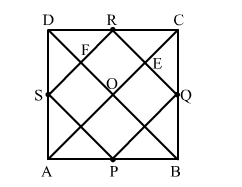Show that the quadrilateral formed by joining the midpoints of the pairs of adjacent sides of a square is a square.
Show that the quadrilateral formed by joining the midpoints of the pairs of adjacent sides of a square is a square.

Let ABCD be a square and P, Q, R and S be the midpoints of AB, BC, CD and DA, respectively.
Join the diagonals AC and BD. Let BD cut SR at F and AC cut RQ at E. Let O be the intersection point of AC and BD.
In ∆ ABC, we have:
$\therefore P Q \| A C$ and $P Q=\frac{1}{2} A C$ [By midpoint theorem]
Again, in ∆DAC, the points S and R are the midpoints of AD and DC, respectively.
$\therefore S R \| A C$ and $S R=\frac{1}{2} A C$ [By midpoint theorem]
Now, PQ ∣∣ AC and SR ∣∣ AC ⇒ PQ ∣∣ SR
Also, PQ = SR [ Each equal to $\frac{1}{2} \mathrm{AC}$ ] (i)
So, PQRS is a parallelogram.
Now, in ∆SAP and ∆QBP, we have:
AS = BQ
∠A = ∠B = 90o
AP = BP
i.e., ∆SAP ≅ ∆QBP
∴ PS = PQ ...(ii)
Similarly, ∆SDR ≅ ∆RCQ
∴ SR = RQ ...(iii)
From (i), (ii) and (iii), we have:
PQ = PS = SR = RQ ...(iv)
We know that the diagonals of a square bisect each other at right angles.
∴ ∠EOF = 90o
Now, RQ ∣∣ DB
⇒RE ∣∣ FO
Also, SR ∣∣ AC
⇒FR ∣∣ OE
∴ OERF is a parallelogram.
So, ∠FRE = ∠EOF = 90o (Opposite angles are equal)
Thus, PQRS is a parallelogram with ∠R = 90o and PQ = PS = SR = RQ.
∴ PQRS is a square.
